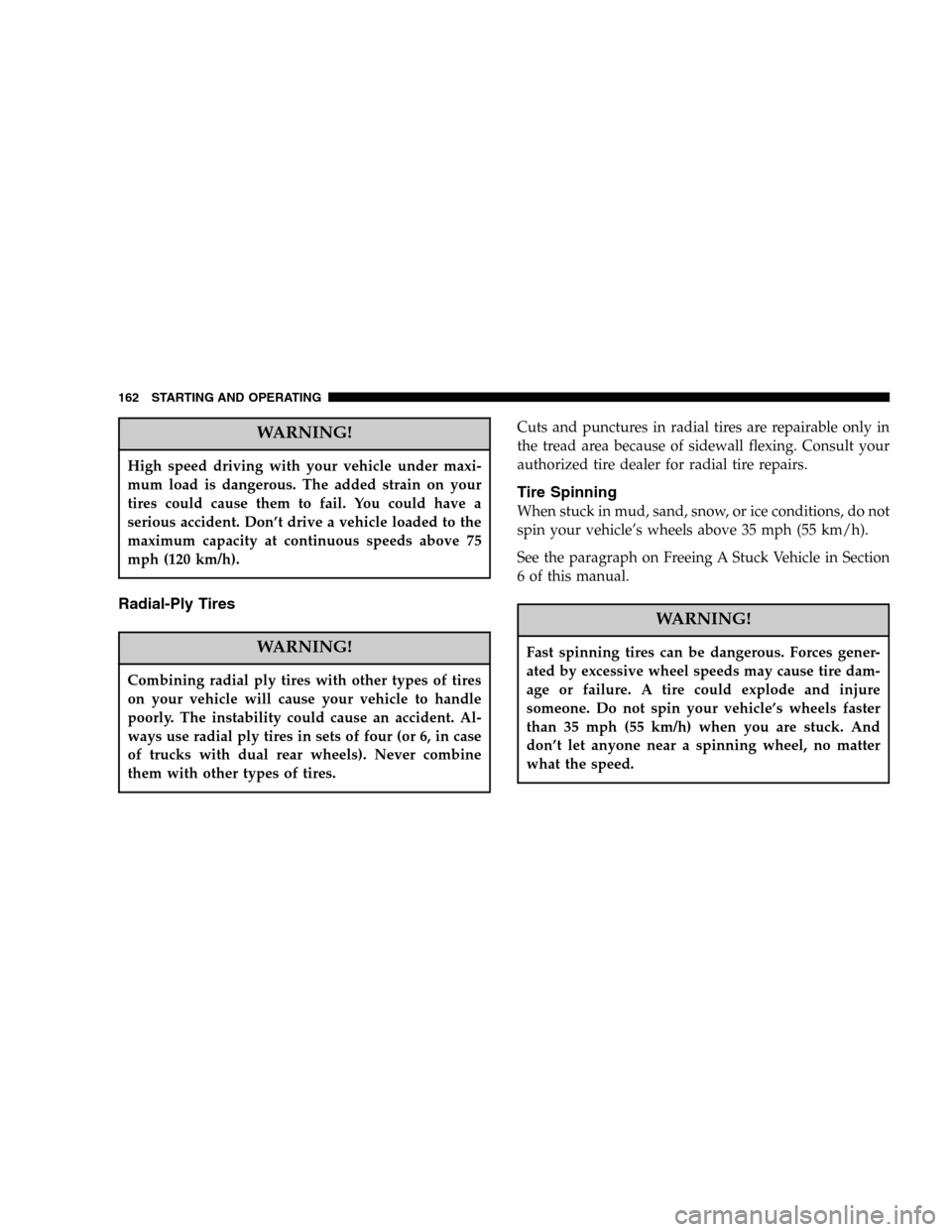Page 162 of 296

WARNING!
High speed driving with your vehicle under maxi-
mum load is dangerous. The added strain on your
tires could cause them to fail. You could have a
serious accident. Don’t drive a vehicle loaded to the
maximum capacity at continuous speeds above 75
mph (120 km/h).
Radial-Ply Tires
WARNING!
Combining radial ply tires with other types of tires
on your vehicle will cause your vehicle to handle
poorly. The instability could cause an accident. Al-
ways use radial ply tires in sets of four (or 6, in case
of trucks with dual rear wheels). Never combine
them with other types of tires.
Cuts and punctures in radial tires are repairable only in
the tread area because of sidewall flexing. Consult your
authorized tire dealer for radial tire repairs.
Tire Spinning
When stuck in mud, sand, snow, or ice conditions, do not
spin your vehicle’s wheels above 35 mph (55 km/h).
See the paragraph on Freeing A Stuck Vehicle in Section
6 of this manual.
WARNING!
Fast spinning tires can be dangerous. Forces gener-
ated by excessive wheel speeds may cause tire dam-
age or failure. A tire could explode and injure
someone. Do not spin your vehicle’s wheels faster
than 35 mph (55 km/h) when you are stuck. And
don’t let anyone near a spinning wheel, no matter
what the speed.
162 STARTING AND OPERATING
Page 164 of 296

Recommended Tire Inflation Pressures
Sport Performance (Y speed rating) tires and All-Season
Performance (W speed rating) tires
Front 225/40 ZR18............... 32psi(221 kPa)
Rear 255/35 ZR19................ 33psi(227 kPa)
Sport Performance (Y speed rating) tires and All-Season
Performance (W speed rating) tires above 100 mph (161
km/h)
Front 225/40 ZR18............... 36psi(248 kPa)
Rear 255/35 ZR19................ 36psi(248 kPa)
Winter tires
Front 225/40 VR18 M+S........... 33psi(227 kPa)
Rear 225/40 VR18 M+S............ 36psi(248 kPa)WARNING!
•When obtaining replacement tires, assure that the
tires are specified for replacement on the Cross-
fire. Tires with the same size, speed, or load
ratings that are specified for replacement on other
vehicles may not properly fit on the original
equipment wheels of your vehicle.
•Do not use a tire, wheel size or rating other than
that specified for your vehicle. Some combina-
tions of unapproved tires and wheels may change
suspension dimensions and performance charac-
teristics, resulting in changes to steering, han-
dling, and braking of your vehicle. This can cause
unpredictable handling and stress to steering and
suspension components. You could lose control
and have an accident resulting in serious injury or
death. Use only the tire and wheel sizes with load
ratings approved for your vehicle.
•Never use a tire with a smaller load index or
capacity, other than what was originally equipped
on your vehicle. Using a tire with a smaller load
index could result in tire overloading and failure.
You could lose control and have an accident.
•Failure to equip your vehicle with tires having
adequate speed capability can result in sudden
tire failure and loss of vehicle control.
164 STARTING AND OPERATING
Page 175 of 296
VEHICLE LOADING
The load carrying capacity of your vehicle is in the
following chart and on the tire pressure label attached to
the driver door pillar.
Vehicle Loading Capacities
Front Seat Occupants....................... 2
Cargo Capacity (with two persons).... 115lbs(52kg)
Rated Vehicle Capacity............ 415lbs(188 kg)
Roof Luggage Rack
Convertible Top Vehicles
CAUTION!
To prevent damage to the convertible top, DO NOT
carry any loads on the convertible top.
Coupe Vehicles
External racks do not increase the total load carrying
capacity of the vehicle. Be sure that the total occupant
and luggage load inside the vehicle, plus the load on the
roof luggage rack, do not exceed the rated vehicle capac-
ity. The maximum recommended roof load for your
vehicle is 110 lbs. (50 kg).
STARTING AND OPERATING 175
5
Page 176 of 296

CAUTION!
•To prevent damage to the roof of your vehicle, DO
NOT carry any loads on the roof luggage rack
which may come in contact with the roof panel.
The load should be secured and placed on top of
the rack, not directly on the roof. If it is necessary
to place some part of the load on the roof, place a
blanket or some other protection between the load
and the roof surface.
•To avoid damage to the roof luggage rack and
vehicle, do not exceed the rated load capacity of
your roof luggage rack system maximum load
capacity. Always distribute heavy loads as evenly
as possible and secure the load appropriately.
•Long loads which extend over the windshield,
such as wood panels or surfboards, should be
carefully secured to both the front and rear of the
vehicle.
•Travel at reduced speeds and turn corners care-
fully when carrying large or heavy loads on the
roof luggage rack. Wind forces, due to natural
causes or nearby truck traffic, can add sudden
upward loads. This is especially true on large flat
loads and may result in damage to the cargo or
your vehicle.
WARNING!
Cargo must be securely tied before driving your
vehicle. Improperly secured loads can fly off the
vehicle, particularly at high speeds, resulting in
personal injury or property damage. Follow the roof
luggage rack “Cautions” when carrying cargo on
your roof rack.
TRAILER TOWING
Trailer towing with your Crossfire is not recommended.
176 STARTING AND OPERATING
Page 250 of 296
Body Specifications
Overall Length 159.8 in. (4058 mm)
Maximum Width 69.5 in. (1766 mm)
Maximum Width With
Mirrors76.9 in. (1954 mm)
Overall Height
Coupe: 51.5 in. (1307 mm)
Roadster: 51.8 in. (1315 mm)
Front Track 58.8 in. (1493 mm)
Rear Track 59.1 in. (1502 mm)
Wheelbase 94.5 in. (2400 mm)
Front Overhang 32.4 in. (822 mm)
Rear Overhang 32.9 in. (836 mm)
Front Ground Clearance 5.0 in. (127 mm)
Rear Ground Clearance 5.8 in. (147 mm)
Turning Radius 32.2 ft. (9.8 m)
Weight
Coupe: 3010 lbs. (1365 kg)
Roadster: 3097 lbs. (1405 kg)
Maximum Vehicle Load 415 lbs.. (188 kg)
Luggage Capacity
Coupe: 7.7 cu. ft. (215 l)
Roadster: 6.5 cu. ft. (190 l) - Top Up
3.6 cu. ft. (104 l) - Top
Down
250 MAINTAINING YOUR VEHICLE
Page 276 of 296

Loading
The vehicle maximum load on the tire must not exceed
the load carrying capacity of the tire on your vehicle. You
will not exceed the tire’s load carrying capacity if you
adhere to the loading conditions, tire size and cold tire
inflation pressures specified on the Tire and Loading
Information placard and the Vehicle Loading section of
this manual.
NOTE:Under a maximum loaded vehicle condition,
gross axle weight ratings (GAWR’s) for the front and rear
axles must not be exceeded. For further information on
GAWR’s, vehicle loading and trailer towing, see the
Vehicle Loading section of this manual.
To determine the maximum loading conditions of your
vehicle, locate the statement “The combined weight of
occupants and cargo should never exceed XXX kg or XXX
lbs.” or “Vehicle Capacity” on the Tire and Loading
Information placard. The combined weight of occupants,
cargo/luggage and trailer tongue weight (if applicable)
should never exceed the weight referenced here.Steps for Determining Correct Load Limit
1. Locate the statement “The combined weight of occu-
pants and cargo should never exceed XXX pounds” or
“Vehicle Capacity” on your vehicle’s placard.
2. Determine the combined weight of the driver and
passengers that will be riding in your vehicle.
3. Subtract the combined weight of the driver and pas-
sengers from XXX kilograms or XXX pounds.
4. The resulting figure equals the available amount of
cargo and luggage load capacity. For example, if “XXX”
amount equals 1400 lbs. and there will be five 150 lb.
passengers in your vehicle, the amount of available cargo
and luggage load capacity is 650 lbs. (1400–750 (5 x 15) =
650 lb.)
5. Determine the combined weight of luggage and cargo
being loaded on the vehicle. That weight may not safely
exceed the available cargo and luggage load capacity
calculated in step 4.
276 IF YOU NEED CONSUMER ASSISTANCE
Page 277 of 296
6. If your vehicle will be towing a trailer, load from your
trailer will be transferred to your vehicle. Consult this
manual to determine how this reduces the available
cargo and luggage load capacity of your vehicle.
NOTE:The following table shows examples on how to
calculate total load, cargo/luggage and towing capacities
of your vehicle with varying seating configurations andnumber and size of occupants. This table is for illustra-
tion purposes only and may not be accurate for the
seating and load carry capacity of your vehicle.
NOTE:For the following example the combined weight
of occupants and cargo should never exceed 865 lbs. (392
Kg).
IF YOU NEED CONSUMER ASSISTANCE 277
9
Page 279 of 296
WARNING!
Overloading of your tire is dangerous. Overloading
can cause tire failure, affect vehicle handling, and
increase your stopping distance. Use tires of the
recommended load capacity for your vehicle-never
overload them.
IF YOU NEED CONSUMER ASSISTANCE 279
9